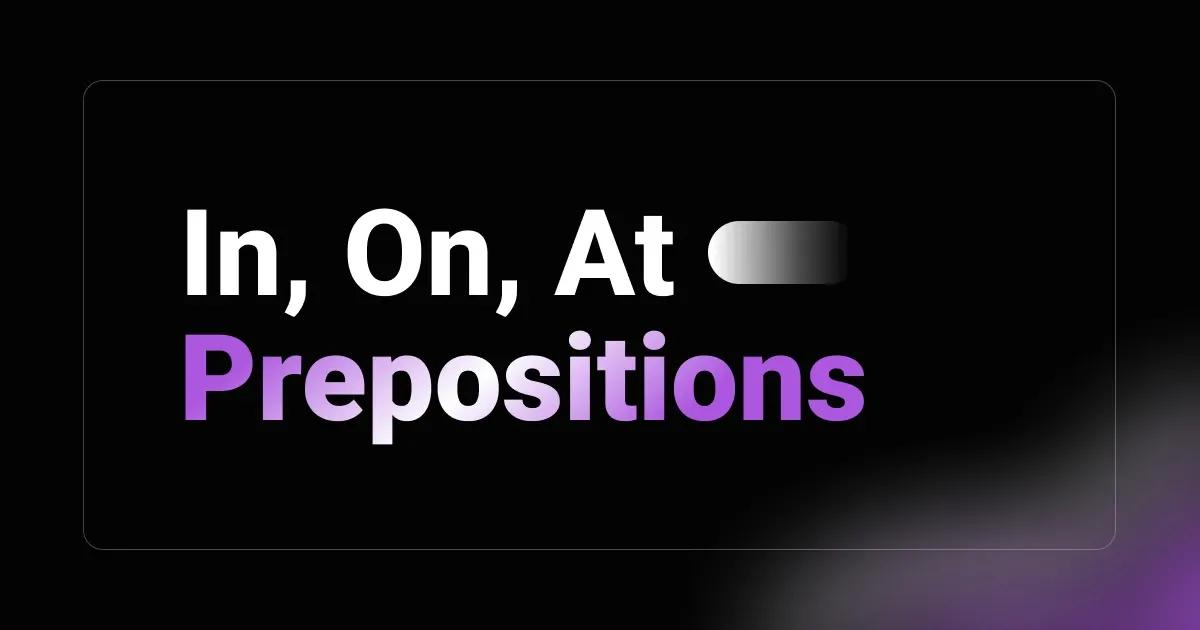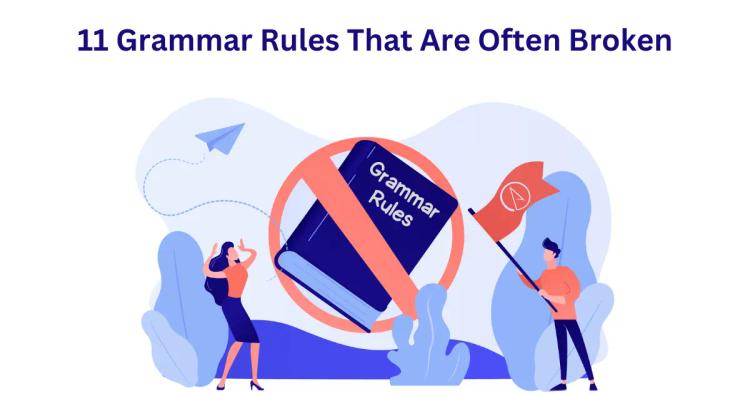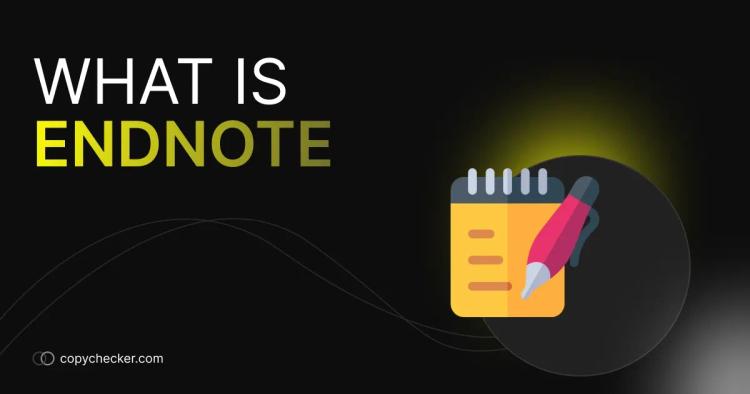Imagine a world without signposts or directions – confusing, right? English prepositions are like those helpful signposts in our language journey. They guide us, showing us where things are happening, when they're happening, and the exact spot in space.
They're the glue that holds our sentences together, adding depth and clarity to our words. In everyday conversations and writing, prepositions silently shape our expressions, making sure others understand us.
They might be small words, but their impact is huge. So, buckle up as we navigate the world of "in," "on," and "at," the superheroes of English prepositions.
Common Challenges with "In," "On," and "At"
Before we jump into the details, let's acknowledge the bumps on the road. Mixing up these three prepositions is confusing left and right – it happens to the best of us. But fear not, we're here to untangle the web and make these little words your best friends.
Understanding "In," "On," and "At"
Mastering the use of "in," "on," and "at" involves understanding their roles in various situations. Let's explore each one in more detail.
1. "In" for Enclosed Spaces
The preposition "in" is like a cozy blanket that wraps around things. It's used for spaces that have boundaries, whether they are physical or more abstract.
In: Preposition of Time Imagine time as a box, and when something happens within that box, we use "in."
In: Preposition of Time Examples
- "I will meet you in an hour."
- "She finished the project in two days."
In: Preposition of Place Think of "in" as your GPS for physical locations.
In: Preposition of Place Examples
- "The cat is in the box."
- "We live in the city."
2. "On" for Surfaces and Position
Now, let's talk about "on." It's like a spotlight, shining on surfaces and positions.
On: Preposition of Time Use "on" when events are happening on specific days or dates.
On: Preposition of Time Examples
- "I have a meeting on Monday."
- "The concert is on the 15th of June."
On: Preposition of Place When something is physically on a surface, think "on."
On: Preposition of Place Examples
- "The book is on the table."
- "She lives on Maple Street."
3. "At" for Specific Points or Locations
Lastly, "at" is like a pinpoint on a map, guiding us to specific points or locations.
At: Preposition of Time Use "at" for precise moments in time.
At: Preposition of Time Examples
- "We'll meet at 3 o'clock."
- "The train arrives at noon."
At: Preposition of Place Think of "at" as marking a specific spot.
At: Preposition of Place Examples
- "I'm waiting at the bus stop."
- "She's at the restaurant."
Understanding these nuances helps us use "in," "on," and "at" effectively, like seasoned navigators in the world of language.
When Not to Use In, On, or At
Understanding when to refrain from using "in," "on," or "at" is just as crucial as knowing when to employ them. Here, we unravel the specific scenarios where these prepositions might not find their perfect fit.
1. Avoiding Overcrowded "In"
- Incorrect: She lives in the city.
- Correct: She lives downtown.
When we talk about general locations like cities, towns, or countries, it's often unnecessary to use "in." Instead, we can dive straight into the heart of the place.
2. Skipping "On" for General Position
- Incorrect: The book is on the table on the kitchen.
- Correct: The book is on the kitchen table.
When describing the position of an object within a larger entity, such as a room or a building, we can streamline our language and omit the extra "on."
3. Reserving "At" for Specific Points
- Incorrect: They met at the park at 3 PM.
- Correct: They met in the park at 3 PM.
While "at" is excellent for pinpointing specific times, it's not the ideal choice when indicating a general location. In this case, "in" better captures the essence of meeting within the boundaries of the park.
4. Steering Clear of Overused "In" for Events
- Incorrect: We'll see you in the concert.
- Correct: We'll see you at the concert.
Events, like concerts or parties, are more appropriately marked with "at" instead of "in." This ensures clarity and aligns with the notion of being at a specific gathering.
5. Avoiding Redundant "On" for Days
- Incorrect: I'll see you on Wednesday on the morning.
- Correct: I'll see you on Wednesday morning.
When indicating a specific day along with a time, we can directly pair the day with the time, omitting the second "on" for smoother expression.
6. Choosing "In" Over "On" for Time Periods
- Incorrect: She'll be back on a week.
- Correct: She'll be back in a week.
For time periods, such as days, weeks, or months, "in" is the preposition of choice, creating a more natural flow in our sentences.
Understanding when not to use these prepositions sharpens our language skills, allowing us to express ourselves with precision and elegance. As we navigate the dynamic landscape of English prepositions, avoiding these common pitfalls ensures that our communication remains clear and effective.
Copychecker's Grammar Checker Tool
In our quest for polished writing, Copychecker emerges as a reliable ally. This grammar checker tool is like having a friendly editor by your side, helping you polish your sentences for better clarity and correctness.
How Copychecker Helps with Prepositions
1. Preposition Correction Feature
Imagine you're typing away, and suddenly, a little green line appears under a word. That's Copychecker, gently nudging you to reconsider your preposition use. It doesn't just underline; it suggests the right preposition, guiding you toward accurate and effective language.
2. Contextual Suggestions
Copychecker doesn't just look at isolated words; it understands the context of your sentences. If you're talking about being "at" a place, it won't suggest "on" or "in." This contextual awareness is like having a grammar-savvy friend who gets what you're trying to say and helps you say it better.
3. Common Preposition Errors Detected
Copychecker is your grammar detective, spotting common preposition mistakes that might slip past your eyes. It highlights areas where "in," "on," or "at" might be misused, giving you a chance to fix them before your readers notice.
Advantages of Using Grammar Checker Tools
Enhanced Writing Accuracy
Let's face it – we're all human, and humans make mistakes. Grammar checkers act like a safety net, catching those sneaky errors we might overlook. They ensure that your writing is not just good but spot-on in terms of grammar.
Time-Saving Benefits
Editing can be time-consuming, but grammar checkers speed up the process. Instead of spending hours combing through your work, a quick run through a grammar checker can catch errors in a fraction of the time. It's like having a personal assistant who tidies up your writing while you focus on the creative part.
Improving Language Proficiency
Think of grammar checkers as your language coach. They don't just fix mistakes; they teach you. By showing where you went wrong and suggesting corrections, they become valuable tools for learning and improving your English skills over time. It's like having a tutor who guides you toward becoming a better communicator.
Tips for Preposition Mastery
Practice Exercises
Embarking on a journey to master prepositions involves getting hands-on with practice exercises. These exercises act like friendly puzzles, helping us understand when to use "in," "on," or "at" with ease.
1. Fill in the Blanks
Try filling in the blanks in sentences with the correct preposition. For example, "The cat is ___ the box." Is it "in," "on," or "at"? This simple exercise sharpens our instincts.
2. Picture Descriptions
Look at pictures and describe them using prepositions. Is the bird "in" the tree, "on" the branch, or "at" the nest? Connecting visuals with prepositions makes learning more fun and memorable.
3. Daily Journaling
Incorporate prepositions into your daily journaling. Describe your activities using "in," "on," and "at." It could be something like, "I am working ___ my desk," or "I had lunch ___ the park."
Reading for Preposition Awareness
Reading isn't just about enjoying stories; it's a powerful tool for learning prepositions naturally.
1. Identify Prepositions in Texts
As you read, pay attention to how authors use prepositions. Identify where they place objects or events using "in," "on," or "at." This helps you see prepositions in action.
2. Story Retelling
Pick a short story and retell it, making sure to include prepositions accurately. This exercise not only improves your understanding but also enhances your storytelling skills.
Seeking Feedback and Correction
Learning is a collaborative effort, and seeking feedback from others is a valuable part of the process.
1. Peer Reviews
Share your writing with friends or classmates and ask for feedback on your preposition usage. Sometimes, a fresh pair of eyes can catch things you might have missed.
2. Mentor Guidance
If you have a mentor or teacher, seek their guidance. They can provide personalized feedback, helping you understand nuances and refine your preposition usage.
3. Learn from Mistakes
Don't be afraid to make mistakes. Each error is an opportunity to learn and improve. When someone corrects you, embrace it as a step toward mastery.
By incorporating these simple and enjoyable tips into your learning routine, you'll find yourself navigating the world of "in," "on," and "at" with confidence and clarity. Remember, practice, observation, and feedback are your companions on this exciting language journey!
FAQs
What are the prepositions in on and at?
"In," "on," and "at" are prepositions that help us show relationships in time and space.
What are the preposition rules for in and on?
Use "in" for enclosed spaces. Use "on" for surfaces and positions.
Which is the correct preposition in at or on?
Choosing between "in," "at," or "on" depends on the context. "In" for inside, "on" for surfaces, and "at" for specific points.
What are 5 examples of prepositions in a sentence?
I am in the room. The cat is on the table. The party is at Sarah's house. We'll meet at the park. The book is in the bag.
What are English prepositions?
English prepositions are words that show relationships between different elements in a sentence, indicating time, place, or direction.
What type of prepositions are in, on, and at?
"In" is a preposition of enclosed space. "On" is a preposition of surfaces and positions. "At" is a preposition for specific points or locations.
Can in, on, and at be used interchangeably?
No, they can't be used interchangeably. Each has its own specific use, so it's important to choose the right one based on the context.
Conclusion
In wrapping up our journey through the twists and turns of "in," "on," and "at," it's clear that these little words hold big importance in our English adventures. Remember, using them correctly can make our expressions clearer and more precise.
But hey, we all make mistakes! That's where Copychecker comes in. It's like having a friendly guide on your writing journey, helping you fix those little slip-ups and making your words shine.
So, whether you're practicing with exercises, diving into good books, or getting feedback from friends, keep exploring the world of prepositions. It's a journey that makes your language skills stronger, one little word at a time. Happy writing!




